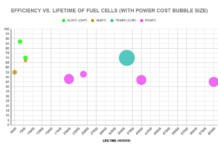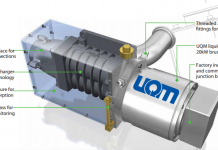by Debra Fiakas CFA
Fuel cell developer SFC Energy, A.G. (F3C.DE) recently came calling on money managers in New York City. The company’s chief financial officer Steffen Schneider wants U.S. investors to know SFC has more going for it than simple fuel cells. True enough the company sells fuel cell components, but it is also capable of delivering complete off-grid energy solutions and integrating full systems.
Schneider talks up SFC’s sterling customer list, including Volkswagen, Siemens, Schlumberger, Shell Oil, Arch Coal, Conoco-Phillips, and other industrial users. Then there are government agencies such as NATO, the FBI in the U.S. and the Israeli military as well as SFC’s home country of Germany. It appears customers have been doing more than just sampling. Over the last five years sales have increased four times, reaching Euro53.6 in fiscal year 2014. That translated to about US$75.0 million at currency rates at the end of the year.
A little over half of SFC’s business is with customers in the oil and gas industry, where production and distribution facilities are often located far away from electrical grid connections. Local energy sources are vital for power controls, data acquisition equipment and other mission critical systems. Harsh weather conditions often preclude the effective use of solar or fossil fuels. SFC estimates the opportunity for off-grid oil and gas facility power sources is valued at US$11.5 billion, of which US3.7 billion in located in the U.S.
![SFC+Emily[1].png](http://www.altenergystocks.com/wp-content/uploads/2017/08/SFC_Emily_1_.png)
Other industries need power in remote locations as well, such as telecommunications, agriculture and agriculture. Wind and solar energy producers also need power solutions for facility control functions. Then there are the remote activities of the military and law enforcement where power is need for communications, computing and monitoring equipment. SFC is prepared to build custom engineered solutions, but some customers can choose standard units such as the EFOY ProEnergyBox or EFOY ProCube. There are also the EMILY and JENNY mobile solutions that give the military or government agencies lightweight and reliable energy packs for personnel deployed in remote locations. The military and industrial markets represent just over a third of total sales.
![SFC+Efoy[1].jpg](http://www.altenergystocks.com/wp-content/uploads/2017/08/SFC_Efoy_1_.jpg) The balance or about 8% of total sales is to consumers. There is growing demand for power sources for recreational vehicles, boats or homes located far away from power lines. SFC offers standard solutions it calls the EFOY Comfort and EFOY GO to provide lightweight, portable units for on-demand power.
The balance or about 8% of total sales is to consumers. There is growing demand for power sources for recreational vehicles, boats or homes located far away from power lines. SFC offers standard solutions it calls the EFOY Comfort and EFOY GO to provide lightweight, portable units for on-demand power.
SFC stands out among fuel cell developers. The company’s fuel cells use direct methane technology rather than relying on hydrogen reformed from natural gas. SFC says this feature improves the return in investment for their fuel cell solutions, since methane is easier and cheaper to handle than hydrogen.
Besides its product technology SFC has been shrewd about its competitive positioning, using acquisitions to bolt on complementary technologies to further distinguish its power solutions. In 2013, SFC acquired Simark Controls Ltd., a provider of instrumentation, automation power solutions for the oil and gas industry. Based in Calgary, Alberta, Simark is well entrenched in Canada’s oil and gas industry. Its rich experience in custom engineering is now giving SFC an edge in pitching customers in the oil and gas industry. In 2011, the PBF Group B.V. was acquired for its electronics technology that has been critical in helping SFC properly integrate its fuel cells into established conventional electronics infrastructure and devices.
SFC has not been as successful in building profits as it has sales. The gross profit margin has shrunk to 29.2% in 2014 from 39.1% just two years earlier. Unfortunately, the trend has continued in the first half of 2015. The company has yet to achieve profitability, but generated positive cash earnings in 2014, as measured by EBITDA. The company had US$4.3 million in cash on its balance sheet at the end of June 2015, and US$11.6 million in working capital to support operations.
U.S. investors who have an interest SFC will need to acquire shares on a Germany’s Frankfurt exchange. SFC has not registered its shares in the U.S. That should not be a particular problem for the investor who is willing to do a bit of work. SFC Energy is fully reporting, providing German authorities with the same sort of disclosures required in the U.S. SFC Energy even provides English translations of its financial reports on the corporate website. For U.S. investors an interesting feature of European financial reports is the Forecast Report section, which details management’s projects for the next fiscal year sales and earnings.
Shares of SFC Energy have drifted down over the last year after experiencing a dramatic increase in value in 2014. The stock fell through its 50-day moving average near the beginning of the current year and has failed to lift above it since. Dwindling trading volume suggests that the current weakness in the stock has been more the result of limited demand rather than a rush to the exits.
Debra Fiakas is the Managing Director of Crystal Equity Research, an alternative research resource on small capitalization companies in selected industries.
Neither the author of the Small Cap Strategist web log, Crystal Equity Research nor its affiliates have a beneficial interest in the companies mentioned herein.







